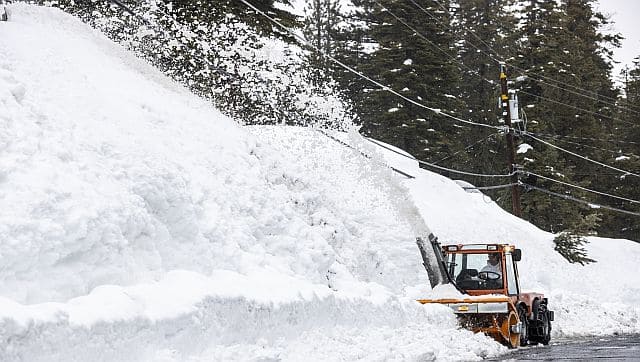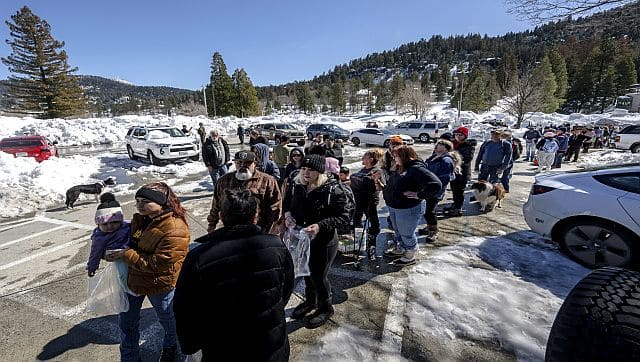Another round of powerful atmospheric rivers is hitting California, following storms in January and February 2023 that dumped record amounts of snow. This time, the storms are warmer, and they are
triggering flood warnings
as they bring rain higher into the mountains — on top of the snowpack. Professor
Keith Musselman
, who studies water and climate change at the University of Colorado’s Institute of Arctic and Alpine Research, explained the complex risks rain on snow creates and how they might change in a warming climate. What happens when rain falls on snowpack? For much of the United States, storms with heavy rainfall can coincide with seasonal snow cover. When that happens, the resulting runoff of water can be much greater than what is produced from rain or snowmelt alone. The combination has resulted in
some of the nation’s
most destructive and costly floods, including the
1996 Midwest floods
and the 2017 flood that
damaged California’s Oroville Dam
. [caption id=“attachment_12297272” align=“alignnone” width=“640”] A snowblower removes snow in Tahoe City, California. AP[/caption] Contrary to common belief, rainfall itself has limited energy to melt snow. Rather, it is the warm temperatures, strong winds and high humidity, which can transport substantial energy in the form of
latent
and
sensible heat
,
that predominantly drive snowmelt
during rain-on-snow events.
A snowblower removes snow in Tahoe City, California. AP[/caption] Contrary to common belief, rainfall itself has limited energy to melt snow. Rather, it is the warm temperatures, strong winds and high humidity, which can transport substantial energy in the form of
latent
and
sensible heat
,
that predominantly drive snowmelt
during rain-on-snow events.
Snowpack has air spaces that water can move through.
As the rain falls, the water can travel relatively rapidly through the snowpack’s layers to reach the underlying soil. How streams respond to that runoff depends on how much water is already flowing and how saturated the soil is. When the soil isn’t yet saturated, it can dampen or delay a flood response by soaking up rain and melting snow. But when the ground is saturated, snowmelt combined with rain can lead to fast and devastating flooding. One of the challenges for dealing with these rain-on-snow events is that the flood risk is hard to forecast. To predict whether a flood will occur requires knowledge of weather and hydrological conditions. It requires knowing the soil moisture and snowpack conditions before the storm, the elevation at which rain transitions to snow, the rainfall rate, the wind speed, air temperature and humidity, and estimates of how those factors contribute to snowmelt.
Also Read: How climate change could cost Germany trillions of euros
Additionally, each factor varies in time during a storm and varies in complex ways, especially across a mountainous landscape. This is why rain-on-snow floods are characterised as
compound extreme events
. Despite the extensive damage they can cause, it may be surprising how little is known about how they vary in time, spatial extent and intensity. California is getting another atmospheric river, with more rain on snow expected. How does the rain-on-snow effect differ by elevation in the mountains there? In the California mountains right now, it’s the middle elevations that people need to pay attention to. The lower elevations have primarily seen rainfall rather than snow, so there is less snowpack to melt. And in the highest elevations, colder temperatures promote the continued accumulation of deep snowpack and rainfall is less likely. In
the middle transition zone
— where either substantial rainfall or snowfall can occur — rain-on-snow events are most common, causing both melting and risk of roof collapses. [caption id=“attachment_12297292” align=“alignnone” width=“640”] San Bernardino Mountain residents line up for a chance to get food at a tent in front of the Goodwin & Son’s Market in Crestline, California following a huge snowfall that buried homes and businesses. AP[/caption] If all storms were created equal, there would be well-defined rain zones and snow zones, and the rain-on-snow flood risk would be low. But that isn’t what happens. Instead, not only does the snow zone elevation vary during an event, but it also varies substantially from one storm to the next. The most destructive rain-on-snow events occur when rivers are already running high and soils are saturated, which can occur in response to a series of warm atmospheric rivers interacting with a deep snowpack — like California’s mountains have right now. The order in which these storms occur — or the storm sequencing — is especially important for assessing flood risk because these events are, in part, caused by rapid shifts between cold periods of snow accumulation followed by warm rainfall events. What does research show about the future risk of rain-on-snow events in a warming climate? Even less is known about how rain-on-snow flood risk may respond as the planet warms. In a warmer climate, there will be less risk of rain falling on snow in the lower elevations
as the snowpack declines
, particularly in warmer regions such as the Pacific Northwest.
San Bernardino Mountain residents line up for a chance to get food at a tent in front of the Goodwin & Son’s Market in Crestline, California following a huge snowfall that buried homes and businesses. AP[/caption] If all storms were created equal, there would be well-defined rain zones and snow zones, and the rain-on-snow flood risk would be low. But that isn’t what happens. Instead, not only does the snow zone elevation vary during an event, but it also varies substantially from one storm to the next. The most destructive rain-on-snow events occur when rivers are already running high and soils are saturated, which can occur in response to a series of warm atmospheric rivers interacting with a deep snowpack — like California’s mountains have right now. The order in which these storms occur — or the storm sequencing — is especially important for assessing flood risk because these events are, in part, caused by rapid shifts between cold periods of snow accumulation followed by warm rainfall events. What does research show about the future risk of rain-on-snow events in a warming climate? Even less is known about how rain-on-snow flood risk may respond as the planet warms. In a warmer climate, there will be less risk of rain falling on snow in the lower elevations
as the snowpack declines
, particularly in warmer regions such as the Pacific Northwest.
But at higher elevations, more frequent rain-on-snow events are expected.
While
warmer temperatures
are expected to increase rainfall intensity, research shows that’s not the most important driver of this risk. Much of the expected increase in rain-on-snow flood risk is a result of the
rain-snow transition zone expanding higher
in elevation to include alpine areas that historically received predominantly snowfall. Flood control and reservoir management systems in these mountainous regions will have to consider these future changes in rain-on-snow events — in addition to changes in rainfall intensity and storm sequencing — to
fully understand and prepare for
the local flood risk as the planet warms. So, will projected increases in precipitation extremes and winter rainfall increase rain-on-snow occurrence and the associated flood risk? Or will less snow cover and larger soil moisture deficits reduce rain-on-snow flood risk in a warmer climate?
Also Read: California’s snow-stranded residents need food, plows, help
In a future climate, the response of rain-on-snow flood risk is expected to change in complex and often contradictory ways. The projected changes are
likely to vary
by region, season, climate model, emissions scenario and future time horizon. It’s a
costly risk
that requires more research. This article is republished from
The Conversation
under a Creative Commons license. Read the
original article
. Read all the Latest News
, Trending News
, Cricket News
, Bollywood News
, India News
and Entertainment News
here. Follow us on
Facebook
,
Twitter
and
Instagram
.
This article is republished from
The Conversation
under a Creative Commons license. Read the
original article
. Read all the Latest News
, Trending News
, Cricket News
, Bollywood News
, India News
and Entertainment News
here. Follow us on
Facebook
,
Twitter
and
Instagram
.
)